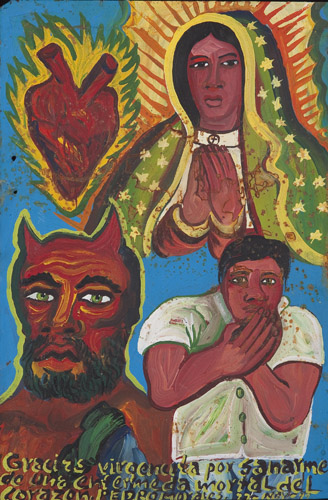Religious tradition and popular culture come together in Mexico City artist David Mecalco’s paintings on tin, wood and paper that have garnered praise and drawn shock.
On view beginning Jan. 31, more than 40 works from the Thomas Wortham Collection of Latin American Popular Arts, donated to the Fowler Museum in 2008, will make up the exhibition “X-Voto: The Retablo-Inspired Art of David Mecalco.”
Though formally trained in the fine arts at Mexico’s National School of Painting, Sculpture and Engraving, Mecalco deliberately paints in the naive style that belongs to untrained artists who do not have a refined grasp of technique.
“We’re not talking about the works of Michelangelo,” said Curator Patrick Polk. “(Mecalco) tries to paint in the style that is traditionally associated with retablos, where you have somebody who might be a local laborer, but on his part time also paints.”
According to Charlene Villaseñor Black, a professor of art history, retablo and ex-voto are terms used interchangeably. In this case, they refer to a small painting done on tin that records a miracle and a thank offering, accompanied by text on the bottom that tells of the miracle that has been worked. Dating back to the 17th century, retablos became very popular in the 19th century with the technology to mass-produce tin.
Local patrons from the middle class purchased less expensive devotional images for the home, while the upper class commissioned much finer works often to be placed in churches.
Thomas Wortham, professor emeritus of English, began collecting Latin American folk and outsider art when he and his partner purchased a Spanish-style house in southern California. Through a friend, he acquired a number of Mecalco’s works that he said he believes represent the best of the artist’s work.
“I was always amused at the reactions when visitors came to my house. The walls are pretty much cluttered, but his work always elicited some comment, generally, “˜I really like that, though that’s strange,’ to “˜How do you live with this?’ to “˜That is really striking,'” Wortham said.
Mecalco’s bold use of color and his staggering sense of design and composition were what caught Wortham’s attention.
“He just seemed to have an imaginative eye that was unlike any of the other retablo painters that I know of,” Wortham said.
Villaseñor Black also owns some of Mecalco’s assemblage work that she purchased at the same La Lagunilla Sunday antiques fair or Thieves’ Market in Mexico City where the artist has sold his work.
“He has a really vibrant colorful style that recalls primitive visual language,” Villaseñor Black said.
Mecalco makes use of this traditional form to explore nontraditional aspects of society, according to curator Polk.
He maintains the feel of traditional retablos and ex-votos while taking them into new realms of social discourse.
The nontraditional subjects that appear in Mecalco’s paintings include themes of homosexuality and prostitution, and images of street life that reflect people’s sexual and personal concerns.
Whereas in the past, according to Villaseñor Black, the miracle event may be divine salvation after falling into a well or protection from being trampled by a horse-drawn carriage, Mecalco depicts miracles of contemporary figures.
These include a self-proclaimed drunk’s offering of thanks to the Virgin for helping him give up alcohol, a prostitute’s thanks for getting work, gay couples’ thanks for finding each other and for their family’s acceptance and even “Spike-haired Pedro”’s thanks for being able to get all of his tattoos.
“(These) people who live alternative lifestyles … would never be seen from the religious church to be blessed or protected by the Virgin Mary and saints,” Polk said. “(Mecalco) expands the tradition. He’s taking it to new places ““ places the traditionalists never thought you would go to.”
According to Polk, the exhibition becomes a reflection of the eternal struggle between good and evil, and the divine and demonic. Retablos reflect dangers of the world and the troubles that can visit upon people, but most importantly demonstrate how they may be triumphed over by holy intercession.
“I think the most important thing is the power of art and artist to engage with the past, to engage tradition for new causes, for new cultural social realities, and help people to hopefully come to grips with things they don’t want to face,” Polk said.
Wortham always intended to give these and other works to the Fowler Museum.
“I thought this justifies my collecting and spending too much money on a variety of things. If I have a goal of giving this to UCLA, it will be worthwhile,” Wortham said.
Wortham said he hopes the exhibition will make people stop, look and talk.
“I think Thoreau says in “˜Walden,’ “˜the most wonderful thing would be to see the world through someone else’s eyes, if only for a moment,'” Wortham said. “That’s what art does, it allows us to share the world through someone else’s eyes.”
